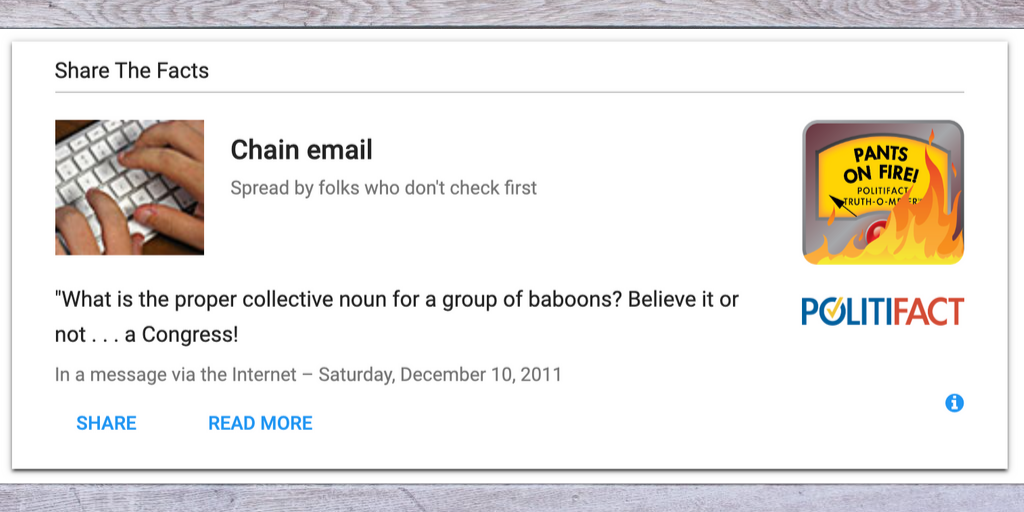The Share the Facts widget started a revolution for fact-checkers, but when we turn off the widget-maker for good this week, no one will get choked up.
Fact-checkers had a love-hate relationship with our widget, a small box they embedded at the end of their articles that showed the person and statement being checked and the rating or conclusion.
They loved how the widget’s hidden code enabled Google and Bing to highlight their articles in search results. But they weren’t keen on the occasional problems we had with widgets mysteriously showing up in unexpected languages. (I don’t blame them, but it was pretty funny to see widgets suddenly show up on U.S. fact-checking sites in Polish and Japanese!)

If a historian ever writes about obscure things that made a difference in journalism, the widget should be included. It grew from a simple idea of Washington Post Fact Checker Glenn Kessler that Google should highlight fact-checks in search results.
After Kessler suggested the idea in 2015, Google Ideas (now called Jigsaw) agreed it was worth exploring. A product manager named Justin Kosslyn pulled together a few stakeholders that included me and the Duke Reporters’ Lab, Cong Yu at Google Research and Dan Brickley from Schema.org, an obscure organization that maintains standards for web publishing.
Together we developed ClaimReview, a hidden “schema” code that summarized the fact-checks. It showed who was checked, what they said, where and when they said it and provided Google, Facebook and potentially any organization that wanted it, with vital details about the fact-check.
But there was a chicken-and-egg problem: Why should any fact-checker add the schema before platforms were using it? Why should platforms use the schema if no publishers were using it? To get the project off the ground, Kosslyn suggested we include a visible box that could be pasted at the end of an article and then shared on social media, adding value to fact-checkers while also invisibly including the schema. We called it the widget.
It worked, at least at first. It helped get the schema’s usage to critical mass so that platforms began to take it seriously.
The hidden part, the ClaimReview schema, worked marvelously. (It lives on today without the widget.) Google and Bing used it to highlight fact-checks in search results and their news products. Articles started showing up in search results with “fact check” tags just as Kessler envisioned. Google and Bing both added new features that highlighted fact-checks. The fact-checkers were thrilled because they got a sudden surge of traffic.
But behind the scenes, we had difficulties. Getting the widgets to show up properly was sometimes tricky because of the aging publishing systems that fact-checkers use. I had gotten a grant from Google and hired project manager Erica Ryan and developer Chris Guess to deploy the schema and the widgets. Guess did a masterful job adapting the widget and code to the creaky publishing systems. He had to make special adjustments so the code and the widget would show up properly in each one.
It’s hard to overstate the value and potential of the ClaimReview code. It creates a universal way to find and catalog fact-checks. Although several of us in journalism such as Reg Chua at Reuters and Laura and Chris Amico of Homicide Watch have evangelized about the value of publishing in a structured form, only a few websites have actually done it. Structured journalism had been most successful for niche products like Homicide Watch or PolitiFact and not many publishing executives have seen value in it.
We leap-frogged over those concerns by creating an international standard for fact-checks that can be used not only for search engines, but it can also provide Facebook with instant details about fact-checks. (Disclosure: The Duke Reporters’ Lab has received funding from the Facebook Journalism Project.)
We also discovered a side benefit: It can power new apps like Squash, a product we’re developing at Duke that can detect what politicians say and match their claims in real-time with previously published fact-checks. The revolution has just begun.
So ClaimReview, the hidden code, is a success. And there are now easier ways that fact-checkers can make it. But the widget, the visible box, never caught on.
We never got many people to share the widgets on Facebook or Twitter. People were accustomed to just sharing a URL, so why bother with our widget? We also hit roadblocks from Twitter, which forced us to render them as simple images rather than interactive elements that could be clicked on.
We got nowhere with our ambitious plan to let people embed widgets in articles the same way they embed tweets. Most publishing systems either prevented this or made it so difficult that we couldn’t get the editors to go along.
And then widgets started showing up in Polish and Japanese. We were mystified. Guess, our lead developer, spent hours troubleshooting but couldn’t figure out the problem.
Last summer, Google engineers unveiled a new way to make ClaimReview without having to embed the hidden code in each article, so we decided to retire the widget. The last one was for a PolitiFact North Carolina fact-check on claims in media reports that Democrats were attending a 9/11 memorial service when Republicans held a controversial vote. It earned a False.
Bill Adair is the Knight Professor of Journalism and Public Policy at Duke University and the director of the Duke Reporters’ Lab.







